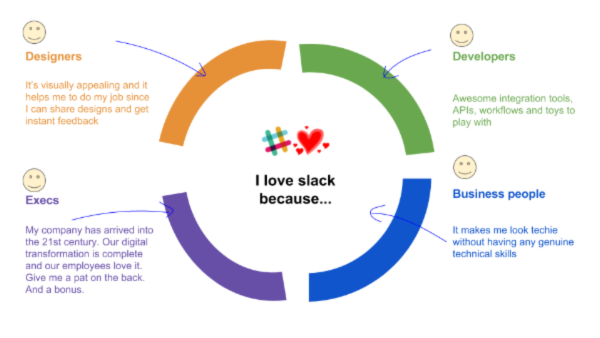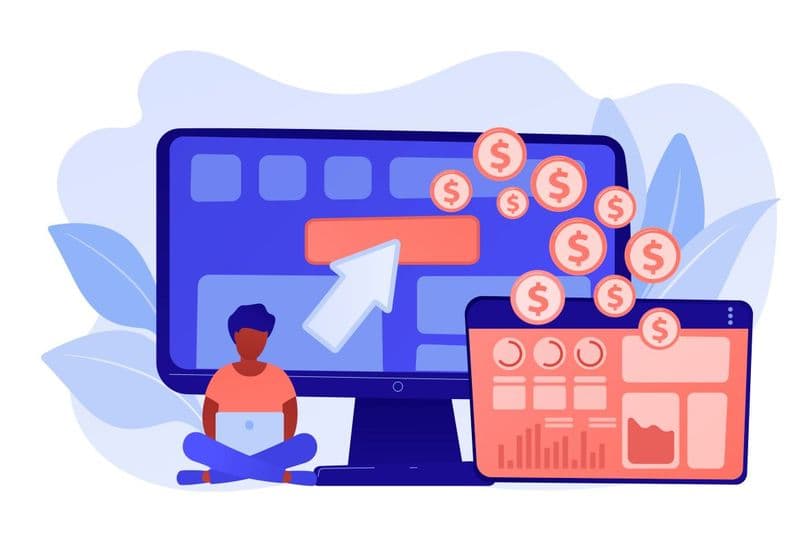
Slack is a popular messaging application for businesses. Its extensive suite of features makes it justified to call Slack the Digital HQ for most business operations.
Slack's tech stack has organized functional spaces for every work requirement. For example, you can share information, enforce deadlines, or collaborate with members live. The voice and video stream smoothly, bringing a sophisticated professional experience to the table. Slack's number of features like these lead it to become a one stop solution for collaborating with team members.
It incorporates texts, files, and multiple channels to help find required information both within and across companies.
Although there are alternative messaging apps, the agility, integrations, and support system make Slack's technology stack impressive and worth looking into.
The services provided by Slack stack are easy and quick, including the best available 24/7 support with 99% uptime. In addition, slack tech’s support is specific and fluid, allowing an integration of Twitter responses, calls, emails, and more.
The integrations make Slack technology a star as it joins with new tools at ease, along with the access to the addition of any popular tool with a paid plan.
What Are the Components of Slack Technology
Since Slack wins over competitive applications for businesses, there is always an ongoing search for what enables Slack’s integration power. The technology stack behind Slack is the reason for its global compatibility. Although the organization has answered the question about its tech stack through a Twitter response, we included all the information here in one place.

Core Engine
Slack is known for both the clean UI and fluid UX. It is built on the core engine Node.js for the back end and React Framework for the front-end with Redux for state management.
Back-end
The technologies to develop an app are using PHP/Hacklang running on HHVM. The back-end programming language is PHP / Hacklang and Java as. The efficient back-end makes extremely scalable and can accommodate for large business needs.
Security System
Slack uses Cloudflare for enhanced web performance and Akamai for delivery performance and security solutions. Slack encrypts data both at rest and in transit. It protects our data with the Slack Enterprise Key Management (Slack EKM) tool, audit logs, and with the help of other top data loss prevention (DLP) providers.
Search Engine
Slack uses Elasticsearch for real-time search and multi-tenancy. In addition, Slack uses Apache Solr for full-text searches in Slack. Solr uses the Lucene Java search library in the background facilitating open-source search software with excellent indexing.
Storage System
Vitess helps in scaling and increasing performance. It is a database clustering system finding its appropriate use in horizontal scaling, installing, and organizing large clusters of the open-source database. It fits with MySQL, which is what Slack uses foractive configuration. With high popularity, Slack has managed to run multiple Vitess clusters worldwide.
Data Warehouse
Open-source tools such as Presto, Spark, Airflow, Hadoop, and Kafka make up the Data warehouse. Slack offers a Redis integration for in-memory store, simplifying data retrieval and caching where large amounts of storage aren't needed. Implementing a robust data warehouse in telecommunication can further streamline data storage, retrieval, and analysis, ensuring seamless scalability and performance across enterprise systems. Data migration from one infrastructure to the other is a breeze.
Data Retrieval
Caching or retrieving stored data finds its source in Memcached, MCRouter. They reduce the load on the server. This activity is specific to frequent calls and content retrieval. For application-level edge caching, Flannel reduces connection time during loading and switching channels. It does so by using relevant data from users through channels and bots. If the Slack client requests query APIs, Flannel helps with fast service.
Messaging
Slack uses Websockets for real-time messaging. They use historical information via web API and real-time data via WebSocket Service in order to enable it.
Load Balancing
HAProxy decreases server traffic. It also balances load balancers. In addition, it ensures user-specific backend service and controls deployment and failover processes for long-lived connections. Slack can also be used with CDNs like Cloudfront for fast content delivery needs.
Server Management
While tools like Terraform and Chef automate infrastructure setup and management, ITIL frameworks help IT professionals streamline service delivery, governance, and lifecycle processes. Taking an ITIL course can therefore complement technical automation skills with strong service management practices. Slack also scores here by using written codes to manage infrastructure than needing a tiresome manual process. Finally, Kubernetes is the virtual machine alternative for automated resource management and scaling application. It allows shared IT operations for quicker code operation and delivery.
Know more abouttechnographicsandtechnographic segmentation
Slack can also be used with AWS so that the orchestration workload falls on Amazon, the cloud vendor, and the users could focus on the functional needs.
Slack Stack for Different Systems
The Slack technology stack keeps in mind the three types of web consumers; web, Android, and iOS.

Web Client
A mix of JavaScript, React, and ES6, along with Electron, is used to develop desktop GUI applications commonly using HTML, CSS, JavaScript, and Chromium technologies. It is suitable for Windows, MacOS, Linux, and cross-application systems. Other apps that use Electron as their framework of choice are Discord, Atom, and Visual Studio Code.
Android
The Android version uses a mix of Java and Kotlin. Kotlin gives a twist to the traditional OOP approach and helps in high-performance applications. It combines OOP and functional programming, while Java enforces an object-oriented design.
iOS
A mix of Objective-C and Swift powers Stack neatly on Apple's phones.
Slack Tech Software Products for Internal Operations:

Image Source: departmentofproduct.com
- Marketing operations run on AdRoll, Convertro, MailChimp, and SendGrid.
- Cnflx, Front, Typeform, and Zendesk run the sales and Support team.
- Analytics uses tools by Google Analytics, Mixpanel, Optimizely, and Presto.
- ProductBoard, Quadro, and Zoom measure and ensure productivity.
With such a robust tech stack, Slack finds its house in more than half of the giant B2B unicorns and holds the market, partnering with more than 500 companies.
Other Tools Like Slack
In conclusion, Slack stands up to the test of time and the immense variety of use cases it has. However, if it doesn't meet your business needs you could look into some Slack alternatives like Microsoft Teams, Rocket.Chat, Ryver, or Flock.
The best messaging service, after all, is the one that works best for you.


